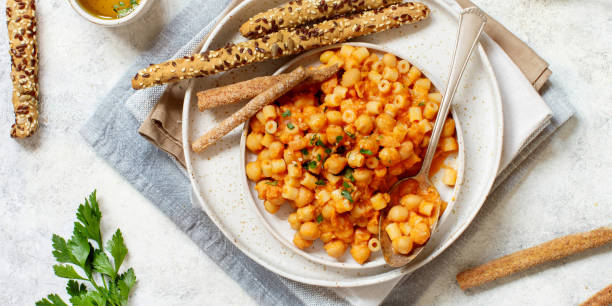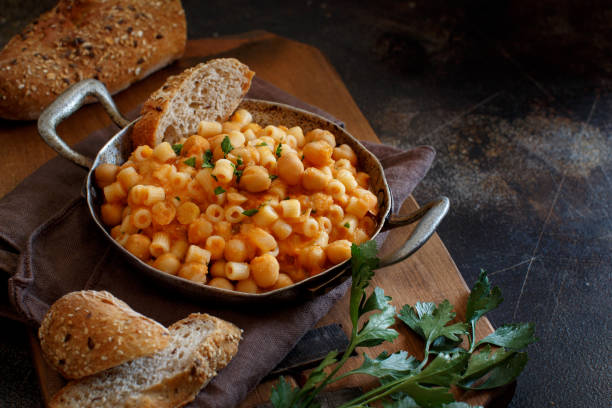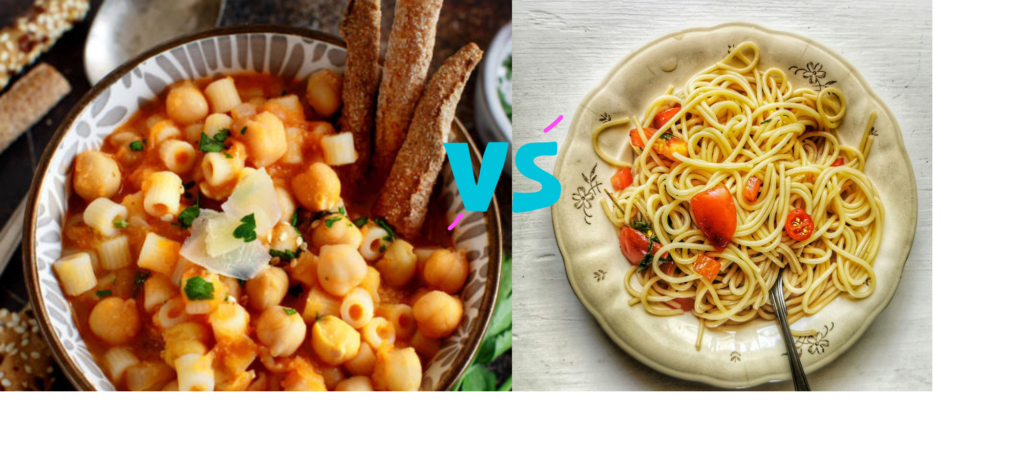Chickpea pasta is gaining popularity as a healthier, gluten-free alternative to traditional pasta, offering a plant-based, protein-rich option for people of all dietary preferences. Whether you’re looking for a way to add more fiber to your meals, reduce gluten intake, or simply explore new culinary trends
chickpea pasta🍝
is an excellent option. In this comprehensive guide, we will dive deep into what chickpea pasta is, its nutritional benefits, and how to incorporate it into your meals with delicious recipes.
What Is Chickpea Pasta?

Chickpea pasta is made from chickpea flour, which comes from dried chickpeas, also known as garbanzo beans. Chickpeas have long been a staple in Mediterranean, Middle Eastern, and Indian cuisines. They are celebrated for their rich nutritional profile, making them an excellent ingredient for health-conscious food products like pasta. This type of pasta is particularly appealing to those who are looking for a gluten-free alternative or a higher protein option compared to traditional wheat pasta.
Nutritional Profile of Chickpea Pasta🍝
One of the primary reasons for chickpea pasta’s rise in popularity is its impressive nutritional content. Here’s what you can expect in a standard 2-ounce serving of chickpea pasta:
- Calories: 190-200 calories
- Protein: 12-15 grams
- Fiber: 8 grams
- Carbohydrates: 32-34 grams
- Fat: 3-4 grams
- Iron: 15-20% of the daily recommended intake
- Magnesium: 10-15% of the daily recommended intake
- Folate: 10-15% of the daily recommended intake

- High in Protein
Chickpea pasta offers significantly more protein than traditional pasta, making it an excellent choice for those following vegetarian or vegan diets. With 12 to 15 grams of protein per serving, it rivals the protein content of many meat-based meals. This helps with muscle repair and is crucial for overall growth and development. Moreover, its high protein content can help you feel fuller for longer, reducing the temptation for unhealthy snacking.
- Rich in Fiber
Another standout benefit of chickpea pasta is its high fiber content. Traditional wheat pasta generally contains around 2 grams of fiber per serving, whereas it offers up to 8 grams of fiber. Fiber plays a critical role in promoting healthy digestion by maintaining regular bowel movements and preventing constipation. Additionally, fiber helps regulate blood sugar levels, lowering the risk of type 2 diabetes and helping with weight management by making you feel full for longer periods.
- Gluten-Free
For those with celiac disease or gluten sensitivities, chickpea pasta provides a fantastic gluten-free alternative. While many gluten-free pastas often compromise on taste or texture, chickpea pasta maintains a firm, satisfying bite and has a slightly nutty flavor that complements a variety of sauces and ingredients.
- Low Glycemic Index
Chickpeas naturally have a low glycemic index (GI), meaning that they cause a slower, more gradual increase in blood sugar levels. Foods with a low GI are especially beneficial for people managing diabetes or looking to sustain consistent energy levels throughout the day. Incorporating chickpea pasta into meals can help prevent energy crashes and improve overall metabolic health.
- Packed with Micronutrients
Chickpea pasta is also a good source of essential vitamins and minerals. It contains iron, which is crucial for maintaining healthy red blood cells and preventing anemia. The high levels of magnesium in chickpea pasta support bone health and nerve function, while folate plays a key role in DNA synthesis and cellular repair, making it particularly beneficial for pregnant women.
Chickpea Pasta vs. Traditional Pasta

While traditional pasta is a classic comfort food, it offers several advantages in terms of nutrition. Here’s a side-by-side comparison of the two:
| Nutrient | Chickpea Pasta (2 oz) | Traditional Wheat Pasta (2 oz) |
| Calories | 190-200 | 200-220 |
| Protein | 12-15 grams | 7-8 grams |
| Fiber | 8 grams | 2-3 grams |
| Carbohydrates | 32-34 grams | 40-43 grams |
| Gluten-Free | Yes | No |
| Low Glycemic Index | Yes | No |
As you can see, chickpea pasta stands out for its higher protein and fiber content, making it a more nutritious option. Additionally, its gluten-free and low-GI properties make it suitable for a broader range of dietary needs.
Health Benefits of Chickpea Pasta🍝
Adding chickpea pasta to your diet can offer several long-term health benefits. Here are some of the ways in which chickpea pasta can improve your well-being:
- Supports Weight Management
The combination of high protein and fiber makes pasta an excellent tool for weight management. Both protein and fiber help you feel fuller for longer periods, reducing the likelihood of overeating and snacking between meals. This can lead to a reduction in overall calorie intake, which supports healthy weight loss or maintenance.
- Promotes Heart Health
Chickpeas, the primary ingredient in our unique pasta, are rich in heart-healthy nutrients like potassium and magnesium. These minerals help regulate blood pressure, reducing the risk of heart disease. The high fiber content also helps lower cholesterol levels, further improving cardiovascular health.
- Enhances Digestive Health
The fiber in this pasta promotes gut health by supporting regular bowel movements and feeding beneficial gut bacteria. This can improve digestive function and reduce the risk of digestive disorders such as constipation and irritable bowel syndrome (IBS).
- Boosts Energy Levels
Thanks to its low glycemic index, chickpea pasta provides a slow and steady release of energy, helping you avoid blood sugar spikes and crashes. This makes it an ideal choice for anyone looking to maintain stable energy levels throughout the day, whether at work, school, or during workouts.
How to Cook Chickpea Pasta Perfectly
Cooking this type of pasta is straightforward, but it requires a few tips to achieve the best texture and flavor. Here’s a step-by-step guide:
- Boil Water: Use plenty of water to avoid the pasta sticking together.
- Season the water by adding a generous amount of salt once it reaches a boil. This helps enhance the flavor of the pasta itself.
- Cook for 7-9 Minutes: Chickpea pasta cooks quickly, usually in about 7 to 9 minutes. Be sure to check for an al dente texture, where the pasta is firm but not hard.
next
- Drain and Rinse: Once the pasta is cooked, drain it and briefly rinse it under cold water. This halts the cooking process and keeps the pasta from turning soft.
- Pair with Sauce or Vegetables: this type of pasta pairs well with both traditional sauces, like marinara or pesto, and more innovative pairings like roasted vegetables, sautéed greens, or a creamy garlic sauce.
Top Chickpea Pasta Recipes to Try
Here are some delicious ways to incorporate chickpeas https://pasta.com/ into your meals:
- Chickpea Pasta Primavera
Ingredients:
- 8 ounces of pasta
- 1 zucchini, sliced
- 1 red bell pepper, chopped
- 1/2 cup of cherry tomatoes, halved
- 2 tablespoons of olive oil
- Salt and pepper to taste
- 1/4 cup grated Parmesan cheese (optional)
Instructions:
- Cook the chickpea pasta according to package instructions.
- In a pan, sauté the zucchini, bell pepper, and tomatoes in olive oil until soft.
- Toss the cooked pasta with the vegetables, season with salt and pepper, and top with grated Parmesan if desired.
Creamy Chickpea Pasta🍝 with Spinach
Ingredients:
- 8 ounces of pasta
- 2 tablespoons of olive oil
- 2 cloves of garlic, minced
- 1 cup of heavy cream (or coconut cream for a dairy-free option) or https://qoqyrecipes.com/the-ultimate-guide-to-pistachio-cream-everything-you-need-to-know/
- Salt and pepper to taste
Instructions:
- Cook the pasta and set aside.
- In a pan, warm the olive oil and cook the garlic until it becomes aromatic.
- Add the cream and spinach, cooking until the spinach wilts.
- Toss in the cooked pasta and mix until well-coated. Serve warm.
Chickpea Pasta Salad with Lemon Vinaigrette
Ingredients:
- 8 ounces of chickpea pasta
- 1 cucumber, diced
- 1/2 red onion, finely chopped
- 1/4 cup of black olives
- 2 tablespoons of olive oil
- Juice of 1 lemon
- Salt and pepper to taste
Instructions:
- Cook the pasta, drain it, and let it cool.
- In a bowl, combine the cucumber, red onion, and black olives.
- Whisk together olive oil and lemon juice, and pour over the salad.
- Toss the pasta with the vegetables and vinegar.

4 thoughts on “Chickpea Pasta”